


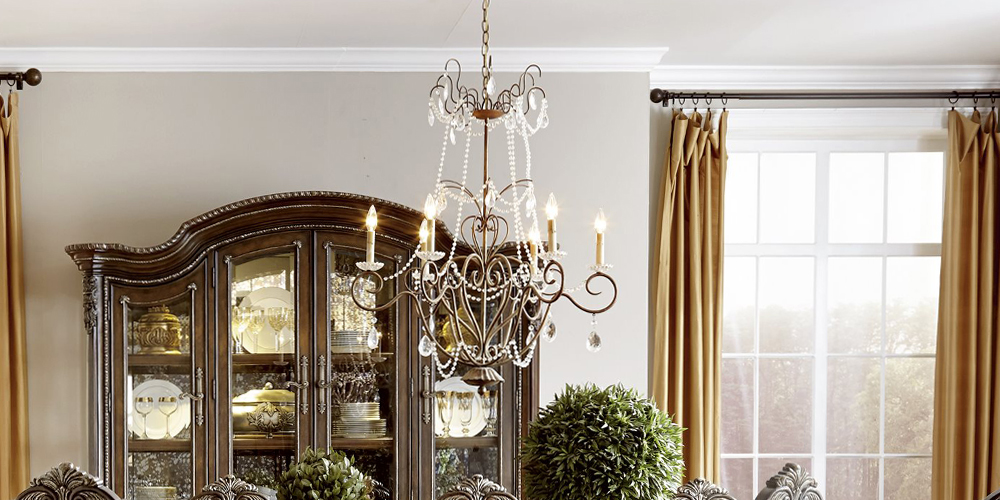
Offering general illumination and a bold decorative statement in any setting, chandeliers have been an interior lighting staple for centuries. These types of overhead lights are defined as an ambient light source, meaning these fixtures dispel uniform light from an indirect source. Large chandeliers are commonly placed above dining tables or in high-ceilinged foyers as a showpiece lighting fixture, while small chandeliers offer scaled decorative impact in other settings. Chandelier types includes a wide breadth of styles and variations, and can appear today in bathrooms, bedrooms, or even a nursery. These types of fixtures are commonly crafted from a combination of glass, crystal, and metals, such as hand-forged iron, steel, and bronze. Most models include a canopy, chain, central body, arms, and bulbs. Popular chandelier features include crystal prisms and flame-shaped bulbs, recalling sophisticated lighting trends from the 19th century. Chandeliers are often associated with opulent living and grandiose aesthetics, though modern, simple designs are widely available. Numerous factors must be considered when purchasing a chandelier.
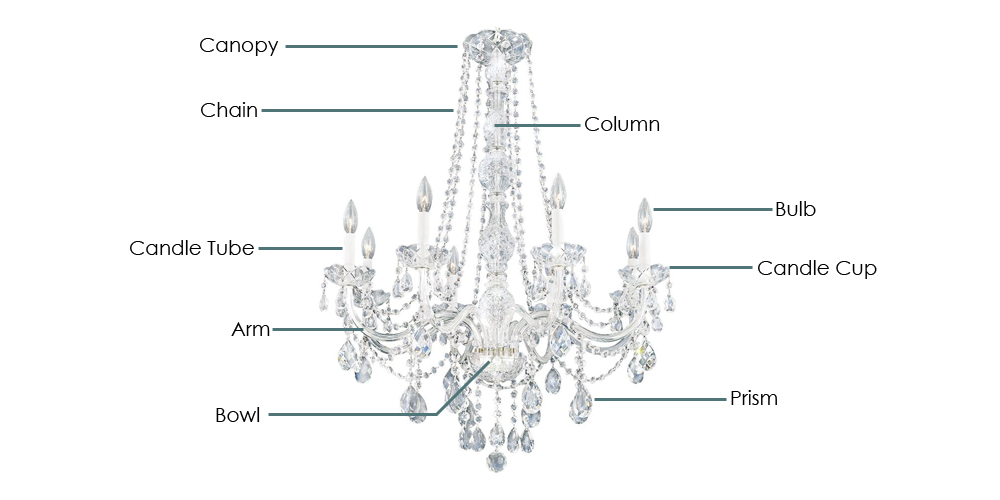
Chandeliers are highly decorative lighting fixtures and commonly include an intricate system of parts. Some chandelier parts are purely decorative, others are purely functional, and many have both functional and decorative value. Generally, the more parts a chandelier has, the more intricate and ornate its design. Common chandelier parts include:
Chandeliers are an ambient lights source, and are commonly compatible with a specific type of bulb. Flame-shaped bulbs are the most popular option for traditional chandeliers, though modern designs or chandeliers with opaque shades may accommodate a wider variety of bulb types. Each bulb types carries unique advantages and disadvantages.
Flame-shaped bulbs imitate the look of a small candle flame. These bulbs were originally used as replacements for candles in the early 20th century and can today add to a vintage aesthetic.
Dimmers are a popular complement to chandeliers in a variety of applications. Dimmers allow you to adjust the light being emitted by the fixture to create ambient lighting ideal to any particular time of day or function of a room.
Chandeliers are either low voltage or high voltage. Low voltage chandeliers, defined at 10V, 12V, or 24V are more common. High voltage chandeliers operate at 120V. If your chandelier is low voltage, it will require a transformer to operate properly. Many low voltage chandeliers include a transformer housed in the canopy of the fixture, and do not require any special installation.
Low voltage lights are defined at 10V, 12V or 24V. Low voltage fixtures are a modern option, and were not previously available. Low voltage lights include a low voltage fixture and a transformer or power pack.
High voltage lights are defined as 120V. High voltage chandeliers limit what types of bulbs can be used, making high voltage undesirable in chandelier design where bulbs are commonly exposed and highly stylized.
Note: Always consult a professional lighting electrication before purchasing or installing a chandelier. This guide is not intended to take the place of a professional's best opinion or serve as a technical safety manual.
Chandelier types include many styles and variations. Many chandelier designs incorporate a varied mix of features, and may bridge two or more chandelier type classifications. Popular features include fabric and glass shades, and crystals or bead embellishments. Chandelier types include:
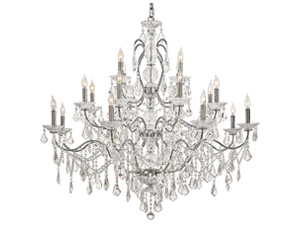
Crystal chandeliers are what we generally imagine when we think of a chandelier. These types of chandeliers are generally elegant and sophisticated, with crystal prisms, scrolling arms, and highly stylized bodies. Crystal chandeliers are oftentimes found over dining room tables or in grand entryways, though they can also appear in powder rooms, walk-in closets, and bathrooms. Modern crystal chandeliers are also available. Popular traditional styles include ornate fixtures with many crystals, and fixtures with only a few crystals combined with shades.
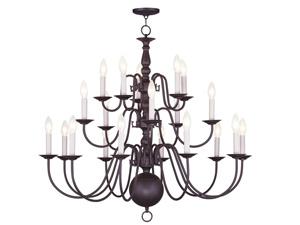
Tiered chandeliers include layers of arms suspended from different vertical points on the center column of the chandelier. Tiered chandeliers can have anywhere from two up to five or more tiers.
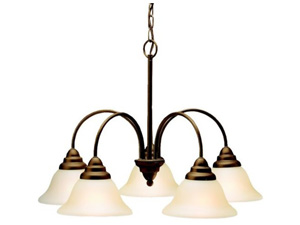
Downlight chandeliers have arms that point down as opposed to up. These types of lights generally include shades to dim the downward facing bulbs, and are a popular option over dining room tables.
Chandeliers run the gamut of styles, finishes, and embellishments. Popular finish colors include silver, bronze, and gold. Chandelier styles include:
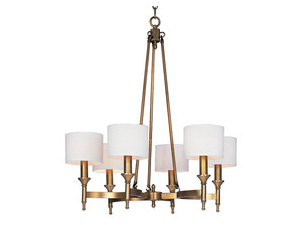
Transitional chandeliers bridge the gap between traditional and contemporary styles, lifting elements from both new and timeless design for a unique look. These fixtures may include sleek lines with some decorative ornamentation, elegant curved frames, and light detailing. These chandeliers can be the perfect combination of traditional elegance, and sleek modernity. Transitional chandeliers are very versatile, and are perfect for someone who loves to re-decorate and play with different design styles.
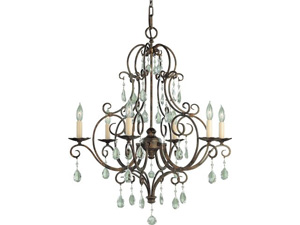
Traditional chandeliers draw upon time-honored motifs for their design. These fixtures are highly ornamental, and may recall a vintage European aesthetic. More so than other fixture types, traditional chandeliers may include components that offer no functional use, but recall the familiar appearance of antique chandeliers, such as candle cups and candle tubes.
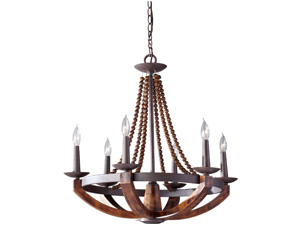
Popular in country or quaint home design, rustic lighting integrates organic shapes, textures, and weathering for a warm, relaxed look with regained modern appeal. Crafted from metal, wood, or even antlers and horns, rustic chandeliers are mainly characterized by their materials. Rustic chandeliers look perfectly placed in cabins and lodges.

Contemporary industrial style chandeliers mimic turn-of-the-century factory design, for a gritty, urban look. These lights use patinaed metals, vintage bulbs, and reclaimed motifs to achieve their signature aesthetic.
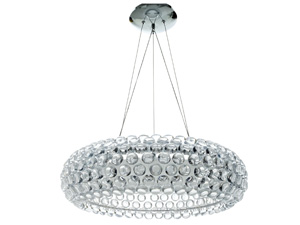
Modern chandeliers can be the perfect focal point above a contemporary dining room table, or in an updated living room. Modern chandeliers can also offer a nice contrast as an accent piece in a traditionally decorated space.
When choosing a chandelier, proportion is key. Buying the wrong sized chandelier, either too big or too small, can draw unwanted attention to the fixture. The goal is to have your chandelier blend in effortlessly and compliment the space. Mini chandeliers can be the perfect accent in a small cozy room; however in a large foyer the same chandelier would look underwhelming. You can easily hang small, medium, and large chandeliers throughout your house, as long as they are hung in a complementary space.
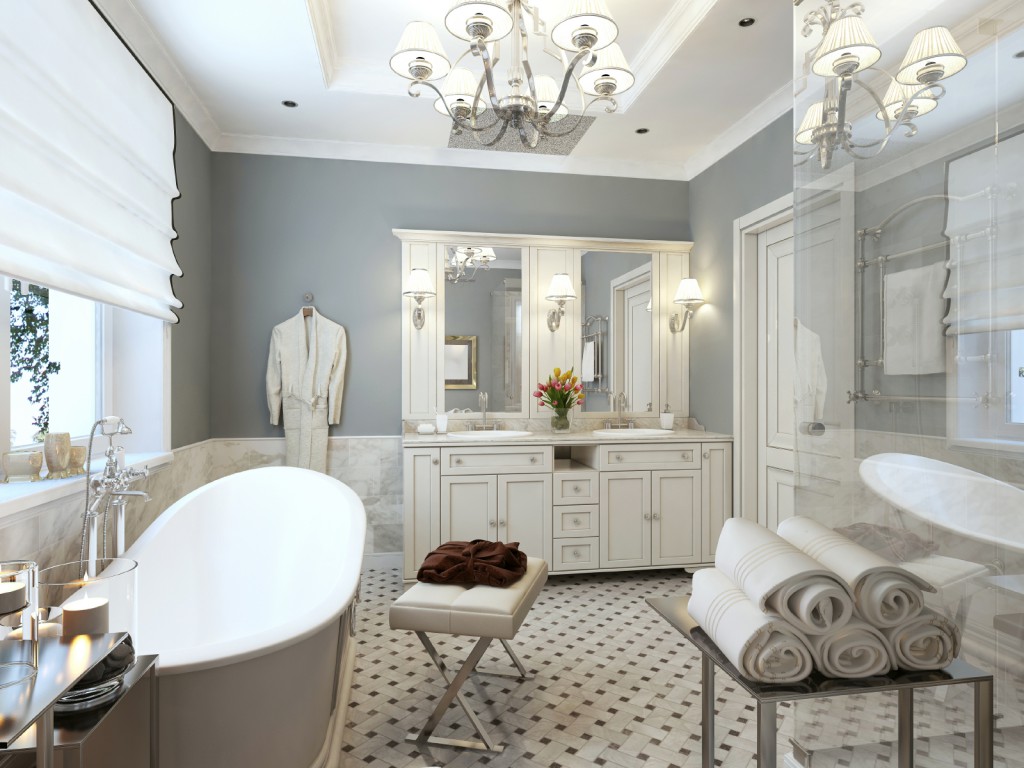
Mini and small chandeliers typically range in size from nine to twelve inches in diameter, making a big impact without taking up much space. Mini and small chandeliers are perfect for intimate spaces like bathrooms, powder rooms, walk-in closets, laundry rooms, and nurseries. Two mini chandeliers can also appear well in larger spaces, as a substitute for one medium sized fixture.
Medium chandeliers are the most common type of chandelier and will work well in practically any space. These types of chandeliers generally measure close to 28” in diameter. Depending on the size of your dining room table, medium chandeliers will work well above the table, acting as a focal point. Medium chandeliers appear well placed in the center of an average-sized bedroom, living room, or kitchen. This size is also ideal for hallways, and for entryways that are on the smaller to medium side.
Large chandeliers are perfect for large rooms and open spaces that are in need of a wow-factor. These chandeliers range from 32” up to hundreds of inches in ballrooms or hotel entryways. This size chandelier works well hung in a large formal dining room or in a large entryway or foyer. Entryway chandeliers can be a great way to make a lasting impression on guests when they enter and leave your home. The most important things to consider when hanging an entry way chandelier are placement and height.
Note: The National Electrical Code mandates that large chandeliers that weigh over 50 lbs must be secured to a building’s structure. We recommend consulting a professional to properly install chandeliers in this weight class.
To decide where to place your entryway chandelier, the first step is to take stock of your space. Chandeliers shouldn’t hang below the second floor in two-story entryways. In standard height foyers, a chandelier should be at least seven feet above the floor. The chandelier should be in the center of the space, in most cases directly in line with the front door to appear balanced.
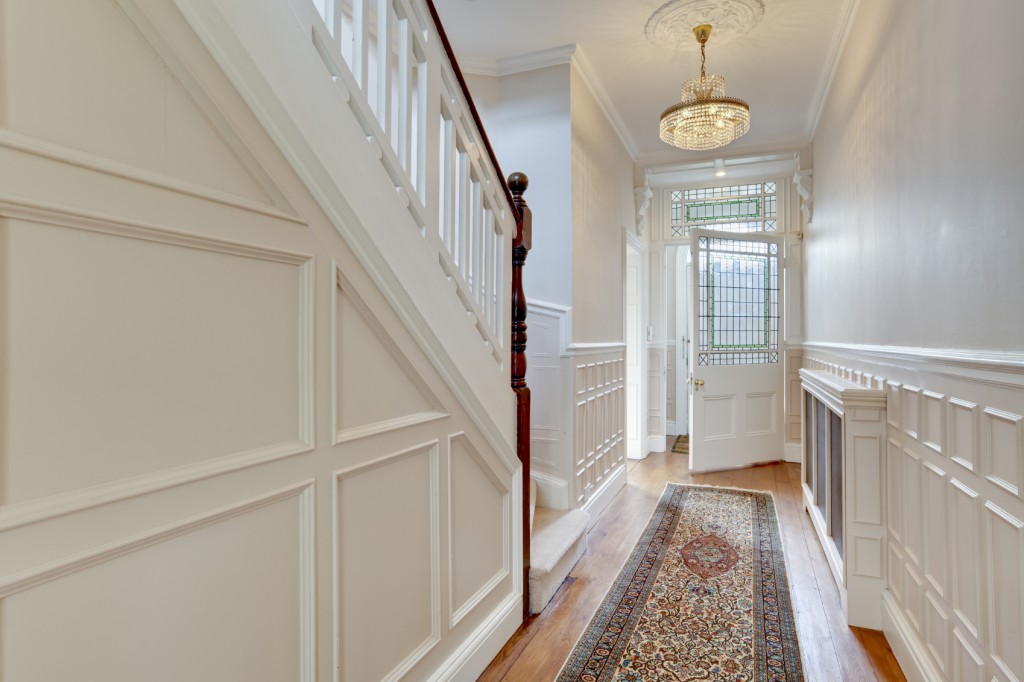
Height: The height of your chandelier should reflect the height of your ceilings. Most designers recommend that for each additional foot of ceiling height you should add about three inches to the suspension height.
Chandeliers are perfect for anchoring a dining room table, and add to a timeless dining aesthetic. The most important things to consider when hanging a chandelier above a dining room table are height, size, and placement of the fixture.
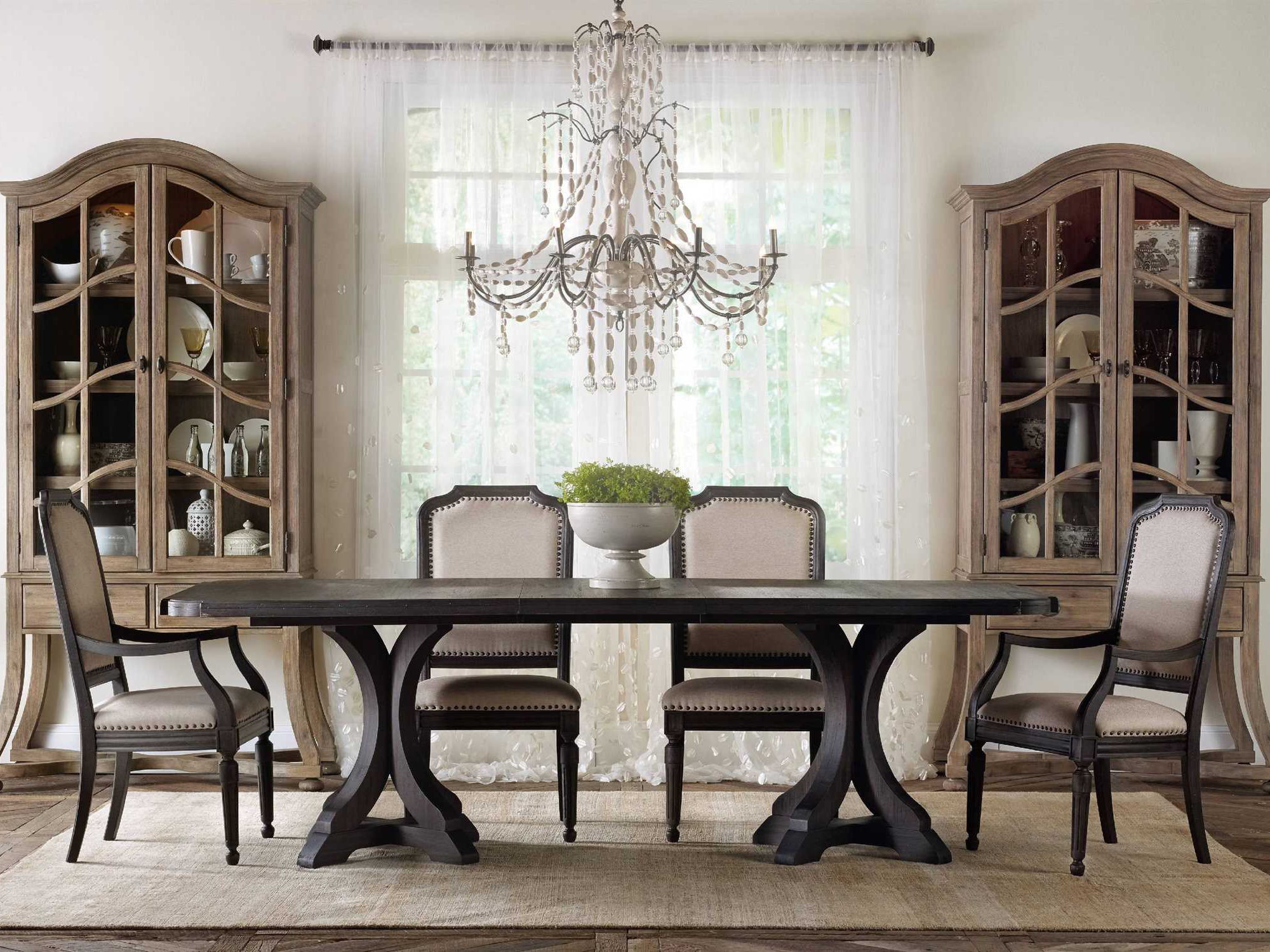
Size: Choose a chandelier that has a diameter one foot narrower than the table’s width. This will ensure that no guest bumps their head on your fixture while excusing themselves from the table.
Height: A good rule of thumb to follow for hanging dining room chandeliers is that the bottom of the chandelier should hang between 30 and 36 inches from the top of the table, assuming you have an eight foot ceiling. You can raise your chandelier even higher if you want to leave enough room below for a flower arrangement or a centerpiece on the table.
Placement: Chandeliers should always be centered and hung in the middle of the dining room table. If two small chandeliers are hung above a dining room table, they should be placed in a line parallel with the table’s longest side, and at an even distance from the center of the table.
For optimal illumination and a well-balanced look, place the chandelier at the center of the living space. Since this space sees a high level of traffic, but sure to hang the chandelier at least 7 feet above the ground. A living room chandelier will ideally be placed directly above a coffee table or large ottoman.
A small chandelier adds a touch of glamour and sophistication to most bathrooms. The chandelier can be placed above a tub, at the center of the room, or above a vanity. Leave 8 feet of clearance between the highest edge of the tub and the lowest point of the chandelier if hanging above the bathtub.
Chandeliers constructed from certain kinds of metal will naturally tarnish with age. The tarnishing process yields to a heritage, antiqued look that is widely desireable. To slow this natural tarnishing, appropriate wax cleaners can be used.
Always use a stepladder and a drop cloth placed on the floor below your chandelier when cleaning your fixture. A ladder makes it easier to effectively and safely clean the chandelier, and a drop cloth will catch any dust, chandelier parts, or crystals that may fall from the fixture during the cleaning process.
Use cotton gloves when cleaning your chandelier to prevent fingerprints, and wipe down the frame portion of the fixture with a dry cotton cloth. To remove stubborn stains or buildup from crystals use a natural, water-based cleanser, and avoid getting any wet solutions on metal parts of the chandelier. Regularly dust your chandelier using a dry cloth or wool duster.



